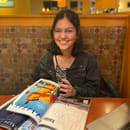We can’t really tell original stories, and that is OK.
I came up with the best story ever when I was 11 years old. It was set in a magical world, and there was a fancy royal-like school; I had a magic system and full world building. The main character was a young girl with magic who discovered she was special and had some power that not everyone else had. She made friends and love interests at the school. The plot was solid, and I had planned it out fully into six books.
About a week later, I realized my magnum opus was just a modified version of Harry Potter.
Every book I’ve tried to write in my head afterward has gone through the same realization: it doesn’t matter how creative I try to get because it has all been done before.
You could sit down and write the main plot of some of your favorite stories as simplified as possible, and when you read them all together, they might seem very similar. The same way that modern romance movies, like “10 Things I Hate About You” and “West Side Story,” are based off Shakespeare classics. We find inspiration in everything we consume, so we tend to copy each other’s “original” stories.
We could go back to the literary canon and blame it on the classics for taking all the original ideas from us, but who is to say Mary Shelley was the first to come up with the idea of making a monster and a mad scientist reflect each other’s flaws?
Thomas C. Foster explains it better in his book “How To Read Literature Like a Professor?” He says that there is only one story, “Wherever anyone puts pen to paper or hands to keyboard or fingers to lute string or quill to papyrus. They all take from and in return give to the same story.” There is no such thing as originality because this story has been told for our entire existence, it compiles everything that being human means and it tells us nothing at all at the same time.
In telling the story, we stick to structures and archetypes. For example, there is the structure of the “Hero’s Journey,” which we can see in “The Wizard of Oz” or in the “Shrek” movies. This format gives freedom to other factors in the plot, but it asks to stick to the storyline of the hero and his or her adventure.
Dan Bronzite writes about the 12 stages of the hero’s journey in his article about mythic structure. Bronzite outlines that the hero – who is part of the ordinary world – is called to go on a challenge or quest, meet a guide or mentor, face minor issues and enemies along the way, reach his or her final fight, obtain his or her reward and come back home, changed forever. The structure is flexible and can be changed into many things, like making the journey not be a physical adventure but rather a journey inside the protagonist’s mind, making his or her adventure a quest of personal growth.
There are other rules in telling a story that we all seem to follow. Foster explains in his book that some of the archetypes tend to be relating to the meaning of simple acts, such as eating, that represent something else.
Joyce Carol Oates wrote for the New York Times that the act of eating or not eating always means something in literature, “For some, food must be symbolic or it is nothing – it must be encapsulated in an ”occasion” or it is nothing. Eating in the wrong circumstances, or with the wrong people, or under duress, or pressure, or in haste is deeply repugnant if not impossible (…) ‘Food is love,’ I was once told.” These representations of ordinary actions in stories serve as metaphors, and like the story that keeps going, they are seen in every piece of media. There are similar archetypes regarding the weather, the seasons, the geography, the colors and many other factors that turn into metaphors that apply to most literary works.
But the fact that all these stories are the same does not have to be something to mourn.
Foster adds to the argument that the idea of the same story brings comfort to readers. We like to see patterns, so when stories repeat themselves, and we can recognize those patterns, we feel closer to the plot, the characters and the ideas they represent. Some stories hit us harder because we can interpret them through these repetitive plotlines; there would be no fun in watching slasher films and whodunits if we didn’t know the guidelines they use to choose a killer.
The one story unites us because it tells our lives. There are a million ways to tell the same tale, and we enjoy every one of them because we are glad that we can share the story. We can repurpose the same experiences and twist them into a new anecdote, and when we do we feel more connected to everyone who has ever been part of the story. The same way I feel connected to authors and characters as I see my own experiences told; like how I believe Jo March was modeled after me, or how I think Taylor Swift bases her lyrics on my personal life.
The story we are telling belongs to all of us and to no one at all, but we can pick at it any time we want and use it for our benefit. We can stretch it out or shape it like a ball of slime. It is the same story, but hearing it always feels like coming home.


